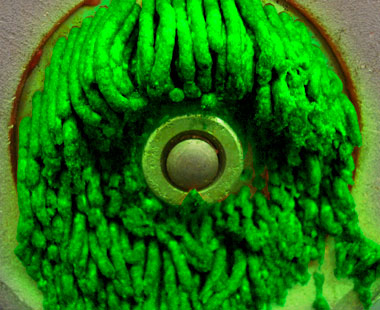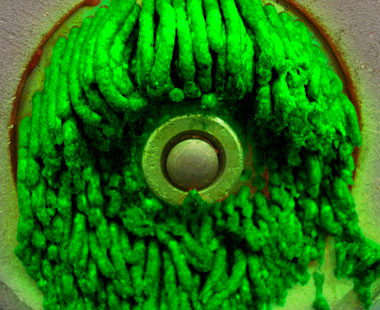 And you thought pink slime was bad.While we all agree that the food industry needs to be able to deliver food free of disease-causing pathogens like E. coli and salmonella, there is no real agreement on exactly how to do that. Irradiation, one of the most controversial of these techniques, is a 50-year-old method that involves exposing the foods to low levels of gamma radiation. This has the effect of killing most (but not all) bacteria on the food (though research indicates it has minimal effect on virus and prions, aka the stuff that causes Mad Cow).
And you thought pink slime was bad.While we all agree that the food industry needs to be able to deliver food free of disease-causing pathogens like E. coli and salmonella, there is no real agreement on exactly how to do that. Irradiation, one of the most controversial of these techniques, is a 50-year-old method that involves exposing the foods to low levels of gamma radiation. This has the effect of killing most (but not all) bacteria on the food (though research indicates it has minimal effect on virus and prions, aka the stuff that causes Mad Cow).
Generally speaking, only a small set of irradiated foods are commercially available; some spices, some mail-order ground beef, and some tropical fruits like mango, papaya, and guava make the grade. But the list of foods legally approved for radiation treatment is actually quite long. From the USDA:
Fresh meat and poultry including whole or cut up birds, skinless poultry, pork chops, roasts, stew meat, liver, hamburgers, ground meat, and ground poultry are approved for irradiation.
U.S. food regulations also allow the irradiation of wheat and wheat powder, white potatoes, many spices, dry vegetable seasonings, fresh shell eggs, and fresh produce.
 The radiation sign and slightly-more-appetizing radura symbol. When stated like this it all sounds fairly reasonable, which is why the industry loves to compare it to widely accepted treatments like pasteurization. Even so, federal regulations require that any food which received radiation treatment must be labeled — not with the classic scare-the-bejeezus-out-of-you radioactive hazard symbol, but rather with the far more innocent-looking radura. The phrase “treated with irradiation” appears in small print.
The radiation sign and slightly-more-appetizing radura symbol. When stated like this it all sounds fairly reasonable, which is why the industry loves to compare it to widely accepted treatments like pasteurization. Even so, federal regulations require that any food which received radiation treatment must be labeled — not with the classic scare-the-bejeezus-out-of-you radioactive hazard symbol, but rather with the far more innocent-looking radura. The phrase “treated with irradiation” appears in small print.
In 2005, the beef industry petitioned the FDA to get rid of that minimal label. By classifying irradiation as a cost-saving “processing aid,” they hoped to broaden its use — strange, considering the process could add over 10 cents per pound to the cost of meat, by some estimates.
It’s worth noting that such a per-pound price increase is far beyond the few-cents-per-pound cost of other reforms to industrialized livestock practices. Reducing crowding at feedlots, slowing slaughterhouse line speeds, or banning the routine feeding of antibiotics to animals or the use of battery cages for hens or gestation crates for pigs would all improve the health of the animals and decrease the risk of disease-causing pathogens at far less expense.
Food Safety News now reports that the FDA has finally denied the industry petition. Labeling irradiated beef as such will continue for the foreseeable future; Big Food will have to find other ways to produce safe meat. (Here’s one suggestion: Stop production processes that end up with meat products covered in sh*t!)
I’m a little bit confused, however, as to why the industry is so enamored with irradiation. In 2006, Food and Water Watch gathered observations and data [PDF] from a wide range of research that had been published between 1995 and 2005 on the effects of food irradiation. Food and Water Watch analysts collected some of the adjectives used by researchers in peer-reviewed studies to describe the irradiated foods:
Published research on irradiated foods repeatedly finds that they smell ROTTEN, METALLIC, BLOODY, BURNT, GRASSY, and generally off. The taste is described as like SULFUR, SINGED HAIR, BURNT FEATHERS, BURNT OIL, and RANCID FAT. Meats can turn GREEN, BROWN, RED, or YELLOW. Irradiated oysters give off a YELLOW SALIVA-LIKE excretion. Serious questions arise as to whether this food is wholesome enough to eat.
Some other yummy words used to describe irradiated foods that appeared in other parts of the report include “rotten egg,” “sweet,” “metallic,” “cooked meat,” “barbecued corn,” “off-odor,” and “burned feathers.” Delicious!
Food and Water Watch also quoted research showing that irradiation can change the color of beef to “green/brown” and pork and chicken to an unnatural red. Oh, and the texture of meat as well as vegetables gets trashed, too. Lovely.
I could be wrong, but it sounds like the FDA might’ve saved the food industry’s bacon (literally) by denying their petition and keeping irradiation a little-used technique. But maybe I’m underestimating our appetite for mutant meat.



